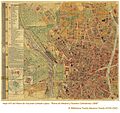Español: Hoja 3 del Plano de Madrid en 1900, dibujado por Facundo Cañada.
Descripción física del plano total por el autor: "El plano consta de 6 hojas, cada una de las cuales mide 59 cm de altura por 72 cm de ancho (de trabajo, por supuesto, nada de anchos de cenefas), y, por lo tanto, al unirlas forman un plano que mide 1,44 metros de ancho y 1,77 de alto y las márgenes en blanco: se está tirando escrupulosamente en ocho colores y en superior papel, hallándose perfectamente grabado" (Facundo Cañada López, 1900).
Descripción cartográfica del plato total: Plano de Madrid y Pueblos colindantes de Aravaca, Canillas, Canillejas, Carabanchel Alto, Carabanchel Bajo, Chamartín, El Pardo (Real Sitio), Fuencarral, Getafe, Hortaleza, Leganés, Pozuelo de Alarcón, con sus barrios de Húmera y Estación; Vallecas, Vicálvaro, Villaverde, etc, al principiar el siglo XX. El plano va acompañado de una Guía, con el Directorio de Madrid y otras notas aclaratorias.
Información estadística y nomenclator del plano por el autor: La superficie del término municipal de Madrid de la época es de 821.189.581 pies cuadrados, equivalentes a 18.621 fanegas del marco de Madrid o sean 6475 hectáreas y 54 áreas; resultando de dicha superficie una proporción de 120,52 metros cuadrados por habitante, pues estos son 528.984, según el último empadronamiento general verificado en 1º de Diciembre de 1900.
En el plano se fijan los nombres de las plazas, calles, callejones, cuestas, etc., que en la actualidad tienen, detallándose la numeración que a cada casa corresponde, dentro de cada manzana, pues se fijan los primeros y últimos números de cada una de éstas al principiar las calles, y después los últimos en las manzanas sucesivas, y de esta manera resulta toda la numeración de cada calle.




